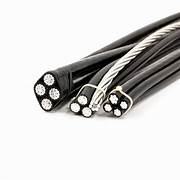The number of insulated conductors in a Low Tension (LT) ABC (Aerial Bundled Cable) can vary depending on the specific design and application requirements. However, a typical LT ABC cable consists of two to four insulated conductors bundled together and covered with a protective sheath.
In this article, we will discuss in detail the construction, features, and applications of LT ABC cables. We will also explore the different types of insulated conductors used in LT ABC cables and their properties.
Construction of LT ABC Cable:
An LT ABC cable consists of the following components:
- Insulated Conductors: The insulated conductors are the core components of an LT ABC cable. They are made of high-quality copper or aluminum, which provides excellent conductivity and durability. The insulated conductors are covered with a layer of insulation material, which protects them from moisture, heat, and other external factors.
- Messenger Wire: The messenger wire is a steel wire that provides support to the insulated conductors. It is placed at the center of the cable and provides the necessary strength to the cable to withstand the weight of the conductors and other external loads.
- Neutral Wire: The neutral wire is an optional component of an LT ABC cable. It is made of aluminum and is used to provide a low-impedance path for the fault current. The neutral wire is usually placed at the center of the cable and is surrounded by the messenger wire and the insulated conductors.
- Protective Sheath: The protective sheath is the outer layer of the LT ABC cable. It is made of a high-quality, weather-resistant material such as polyethylene, PVC, or XLPE. The protective sheath protects the cable from moisture, UV radiation, and other external factors.
Types of Insulated Conductors Used in LT ABC Cables:
There are two types of insulated conductors used in LT ABC cables:
- Aluminum Conductors: Aluminum conductors are lightweight, cost-effective, and have excellent electrical conductivity. They are commonly used in LT ABC cables for low-voltage applications.
- Copper Conductors: Copper conductors are more expensive than aluminum conductors but have better electrical conductivity. They are used in LT ABC cables for high-voltage applications where high conductivity is required.
Features and Applications of LT ABC Cables:
LT ABC cables offer several features and benefits, which make them ideal for various applications:
- Easy Installation: LT ABC cables are easy to install and require minimal maintenance. They can be installed in a variety of environments, including urban, rural, and mountainous areas.
- Reliable Performance: LT ABC cables are designed to withstand harsh environmental conditions, including extreme temperatures, UV radiation, moisture, and abrasion. They offer reliable performance and can operate continuously for years without any interruption.
- Cost-Effective: LT ABC cables are cost-effective compared to other types of cables. They offer excellent value for money and are ideal for applications where cost is a significant consideration.
- Versatility: LT ABC cables are versatile and can be used in various applications, including power distribution, street lighting, and telecommunications.
Conclusion:
In summary, LT ABC cables are an essential component of modern power distribution systems. They offer several advantages, including easy installation, reliable performance, cost-effectiveness, and versatility. The number of insulated conductors in an LT ABC cable can vary depending on the specific application requirements. However, a typical LT ABC cable consists of two to four insulated conductors bundled together and covered with a protective sheath. The choice of insulated conductors, such as aluminum or Alloy Mixed depends on the voltage and other application requirements.












Leave a Reply